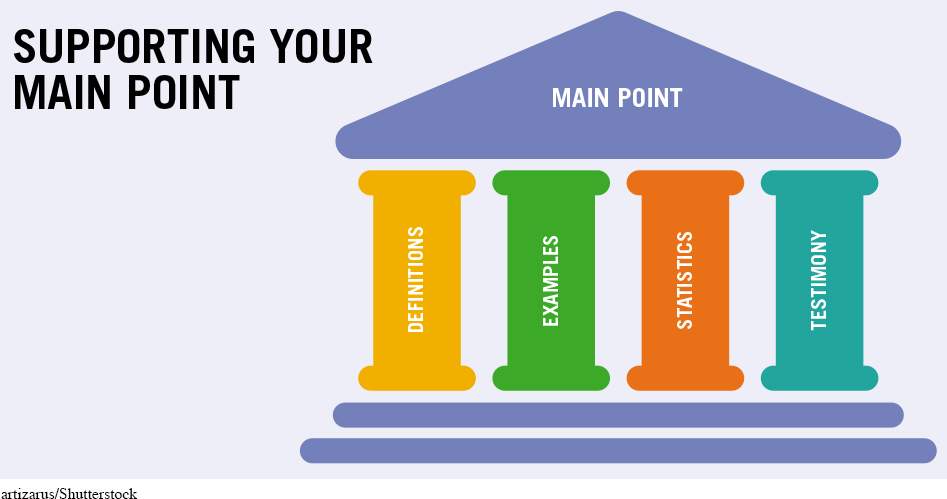Supporting Your Main Points
All your main points and subpoints require supporting materials to clarify the ideas and make them memorable for your listeners. Supporting materials include definitions, statistics, examples, and testimony—
How do you know what type of supporting materials you need? When conducting your audience analysis, consider questions like the following: How familiar is your audience with your topic? Will they need terms defined or other background information? Do you need to include stories and examples that illustrate your points? These types of questions will help you choose appropriate supporting materials that will inform and interest your audience. Although you can base much of your supporting materials on your audience analysis, you might also need to do additional research to fill in any gaps.
Definitions. When composing your speech, be aware of when you may have to define terms for your listeners. After all, as Chapter 5 on verbal communication discusses, differences in language use can cause misunderstandings. Connotative meanings, for instance, are the meanings you associate with words based on your life experiences. But you can’t assume that all members of your audience will share those references. Also, your dialect—
Even within a culture, these differences can cause people who share the same language to misunderstand each other. For example, what comes to mind when you hear the term “medical errors”? When presenting a U.S. Institute of Medicine report about medical errors to a group, Jennie Chin Hansen (2010) realized she should define the term to make sure her audience understood it in the same way she did:
The report was based upon analysis of multiple studies by a variety of organizations and concluded that between 44,000 to 98,000 people died each year as a result of preventable medical errors. A simple definition of a medical error is a preventable adverse effect of some form of medical care. (p. 158)
During your audience analysis, get a realistic sense of terms or concepts you may need to define for your audience. This way, you can provide them with all the information they need but not waste time defining words they already know.
Statistics. A statistic is a number that summarizes a formal observation about a phenomenon. Statistics can help you make a compelling point, such as Hansen does in the preceding quote by stating “between 44,000 to 98,000 people died each year” to give her audience a sense of the severity of medical errors.
When using statistics, keep a few things in mind. First, think about using a visual chart or graph to summarize statistical information. Seeing the numbers in addition to hearing them will help your audience make sense of them. Second, round off large numbers. Instead of listing the exact (but complicated) numbers of medical error deaths in the last few years—
Examples. Main points are made vivid and clear when you use examples, or specific references that illustrate ideas. Real examples are drawn from actual events or occurrences. Consider how this speaker uses a real example to show how the United States has been a leader in space exploration:
America is still the only nation to successfully land a spacecraft on Mars. When our latest Mars spacecraft, MAVEN, arrived last September to study the Red Planet’s upper atmosphere, it joined a fleet of orbiters and rovers that we already had on the surface—
Sometimes you’ll develop a hypothetical example—
A special type of example is an analogy, which compares something that is familiar to your audience with something that is unfamiliar to them but that you want them to understand. Analogies are useful for illustrating a particularly difficult main point. Here, a speaker uses an analogy to explain that American medical practices involve multiple principles:
I’ve often used a simple analogy to explain American medicine to people. I use the idea of the interlocking rings as . . . displayed in the Olympic logo. . . . In my analogy, the first ring is the science of medicine, the evidence-
When using an analogy, be sure that the comparison you’re making is clear and will make sense to your audience. Point out the similarities between the two unlike things, and explain why the comparison works.
Testimony. Relying on the words or experience of others by using testimony is a common way that speakers support main points. Speeches incorporate two types of testimony. Expert testimony comes from those who, by way of their academic study, work experience, or research, have special knowledge about your topic. Layperson testimony is derived from those who have personal experience with the topic. For example, in a persuasive speech on stiffening the laws related to drunk driving, a speaker may draw testimony from police officers who enforce the laws (experts), survivors of alcohol-

Testimony can be presented in your speech through direct quotation. A direct quotation uses the exact words of a person to make your point. In a speech about community and police relations, FBI director James Comey (2015) quotes Martin Luther King Jr.:
In the words of Dr. King, “We must learn to live together as brothers or we will all perish together as fools.” We all have work to do—
When using a direct quotation, you have an ethical responsibility to accurately convey the words of the person. Don’t change the words or take the quote out of context. Be clear in citing the source from which you got the quote, and if necessary, provide some background about the person, such as the professional or personal experience that makes the quote relevant.
Testimony can also be presented by paraphrasing, or providing your own summary of another person’s words or experience. Paraphrasing is useful when the original words are too complicated, too long, or too confusing to quote directly. When paraphrasing, do not alter the original meaning of what the person said or experienced. You have the same ethical responsibility to properly cite the source when paraphrasing as you do when quoting.